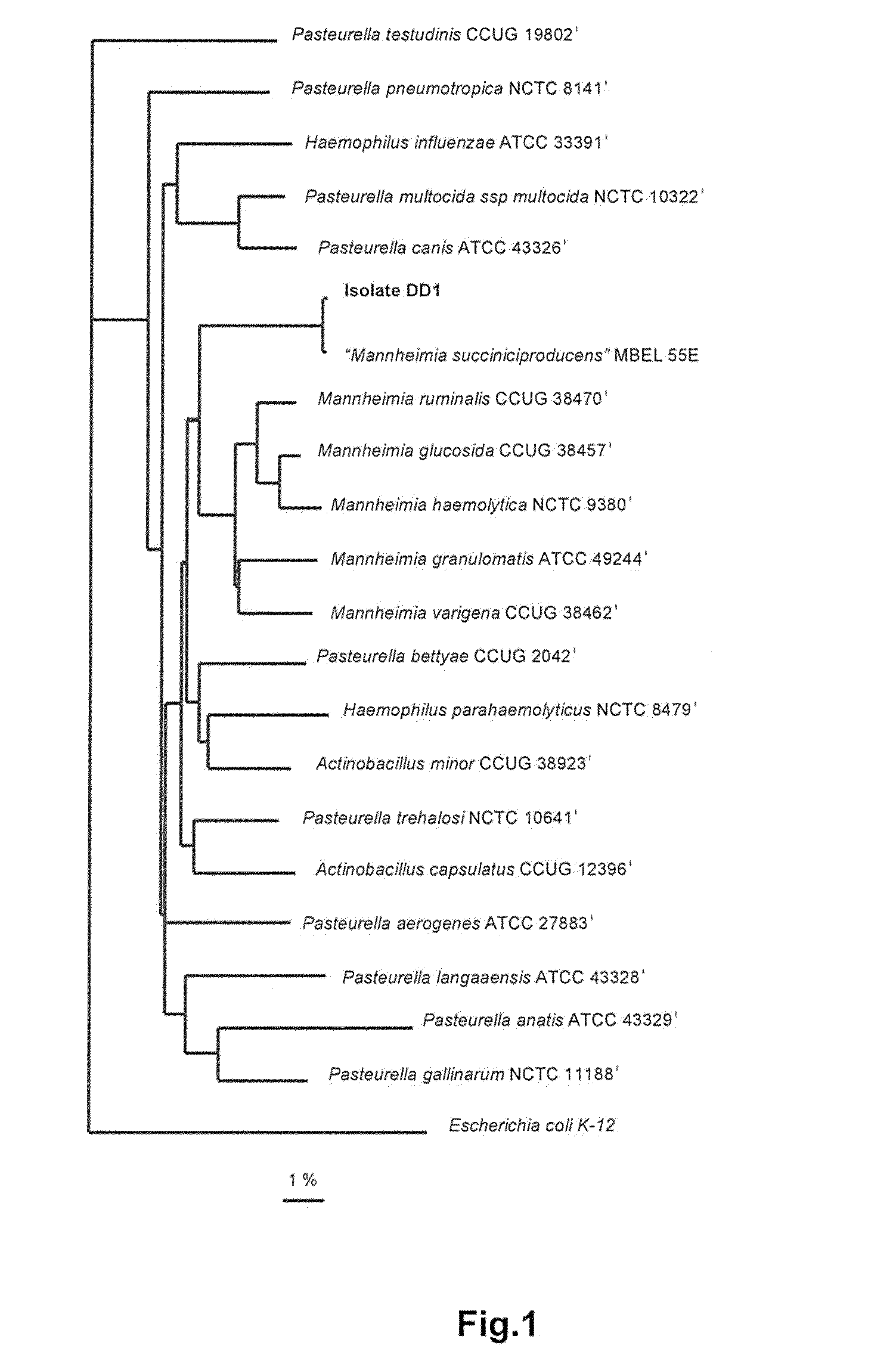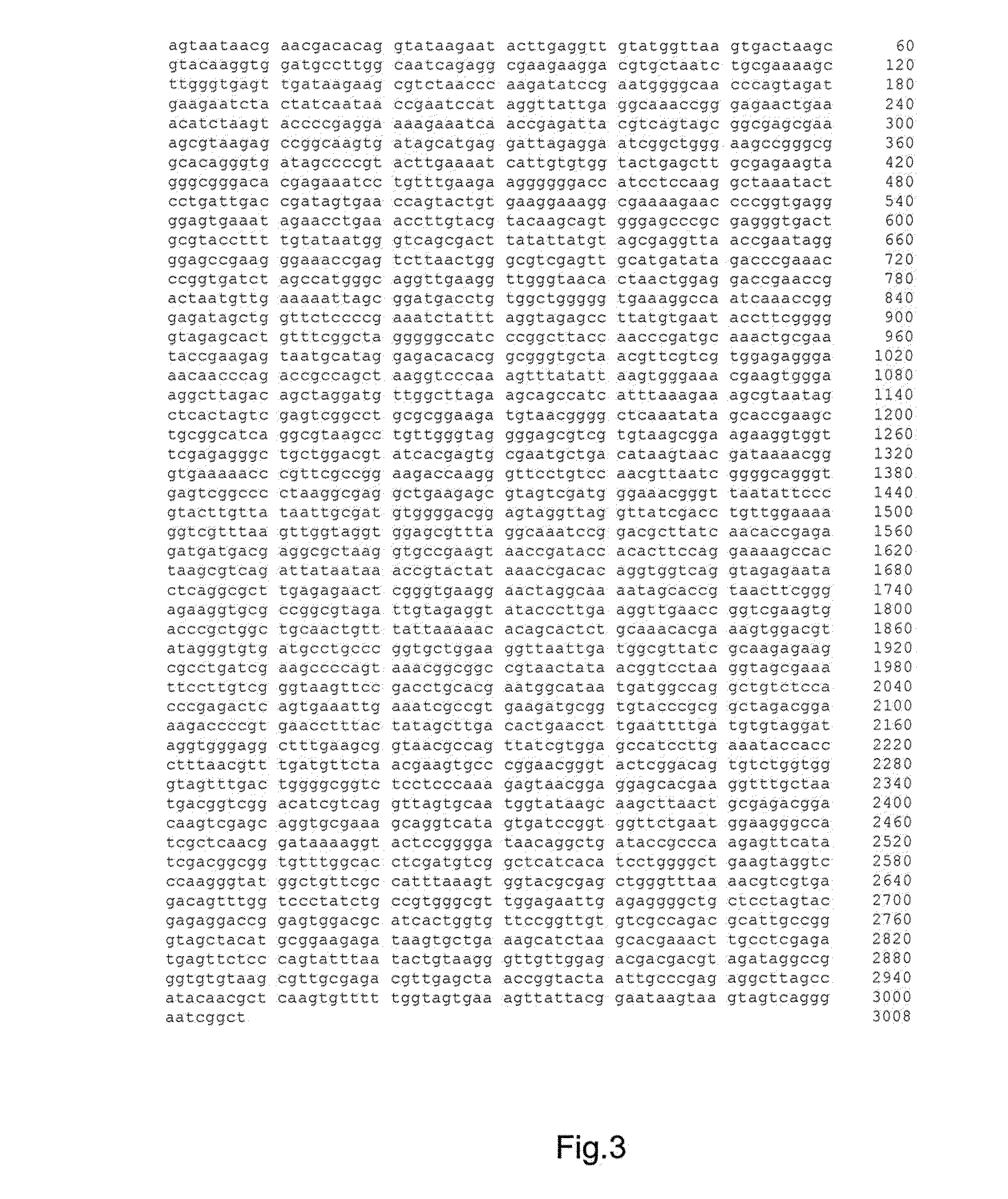Carboxylic Acid Producing Member of the Pasteurellaceae
- Summary
- Abstract
- Description
- Claims
- Application Information
AI Technical Summary
Benefits of technology
Problems solved by technology
Method used
Image
Examples
example 1
Isolation of DD1
[0096]For the isolation a four-step approach was used, comprising the steps of sampling, enrichment cultivation, isolation of pure cultures and test of pure cultures for succinic acid (SA) production.
1. Experimental Approach
1.1. Sampling
[0097]Samples were taken from bovine rumen, digested sludge from a municipal sewage plant and pomace, the residue from wine making. These habitats are characterized by relatively high concentrations of organic substances and a CO2-rich atmosphere without oxygen. More detailed information on the samples, their origin and handling is given below.[0098]a) Rumen content was taken from a canulated Holstein cow at the Institut für Tierernährung, University of Hohenheim. In situ-pH and -temperature were 6.7 and 37° C., respectively. The material was filtered through sterile filter cloth, gassed with CO2 and immediately cooled on ice for the transport and processed on the same day.
[0099]b) Digested sludge was taken from the digestion tower of...
example 2
1. Media Preparation
[0120]Composition of the cultivation media is described in table 8.
TABLE 8Composition of solid and liquid media for the preparation ofDD1 cell banks.Concentrationof stockConcentrationsolutionCompound[g / L][g / L]Glucosevaryinga650Bacto yeast extrakt (Becton Dickinson)5—Bacto peptone (Becton Dickinson)5—(NH4)2SO41500CaCl2*2H2O0.220MgCl2*6H2O0.220NaCl1100K2HPO43500MgCO3varyingb—Bacto-Agar (for solid media only)12aGlucose concentrations were 15 g / L (in plates) and 20 or 50 g / L (in liquid media).bMgCO3 Riedel-de Haen, product number: 13117 by Sigma-Aldrich Laborchemikalien GmbH) concentrations were 5 g / L (in plates) and 0 or 30 g / L (in liquid media).
[0121]5 g yeast extract, 5 g peptone, MgCO3 and (for solid media) 12 g Bacto-Agar were mixed in 900 mL distilled water and autoclaved (20 min). After cooling down to about 65° C. the missing components were added as sterile stock solutions. Glucose, ammonium sulfate and K2HPO4 were all separately ...
example 3
Taxonomic Characterization of DD1
[0125]The taxonomic characterization of strain DD1 was performed via 16S- and 23S rDNA analysis which was conducted as described below:
[0126]Extraction of genomic DNA, PCR-mediated amplification of the 16S rDNA and purification of PCR products were carried out as described by Rainey et al., 1996. A DNA fragment containing the 23S rDNA was amplified by the same method, using the forward primer 5′-AGTAATAACGAACGACACAG-3′ and the reverse primer 5′-AGCCGATTCCCTGACTAC-3′. Purified PCR products were sequenced using the CEQ™DTCS-Quick Start kit (Beckman Coulter) as directed in the manufacturer's protocol. The CEQ™8000 Genetic Analysis System was used for electrophoresis of the sequence reaction products. The ae2 editor (Maidak et al., 1999) was used to align the 16S rDNA sequence of strain DD1 against those of representative members of the ysubclass of the Proteobacteria available from the EMBL and RDP databases. For the construction of the phylogenetic tre...
PUM
 Login to View More
Login to View More Abstract
Description
Claims
Application Information
 Login to View More
Login to View More - R&D
- Intellectual Property
- Life Sciences
- Materials
- Tech Scout
- Unparalleled Data Quality
- Higher Quality Content
- 60% Fewer Hallucinations
Browse by: Latest US Patents, China's latest patents, Technical Efficacy Thesaurus, Application Domain, Technology Topic, Popular Technical Reports.
© 2025 PatSnap. All rights reserved.Legal|Privacy policy|Modern Slavery Act Transparency Statement|Sitemap|About US| Contact US: help@patsnap.com



